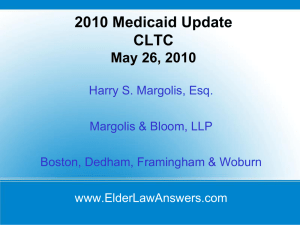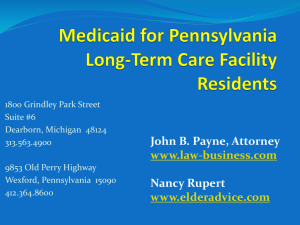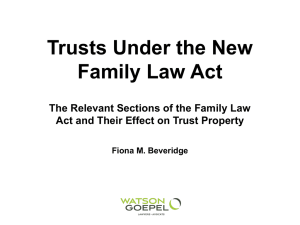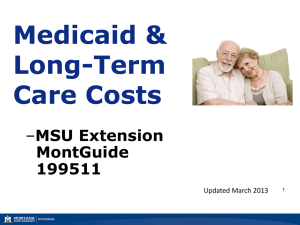the medicaid program`s effect on estate planning for
advertisement
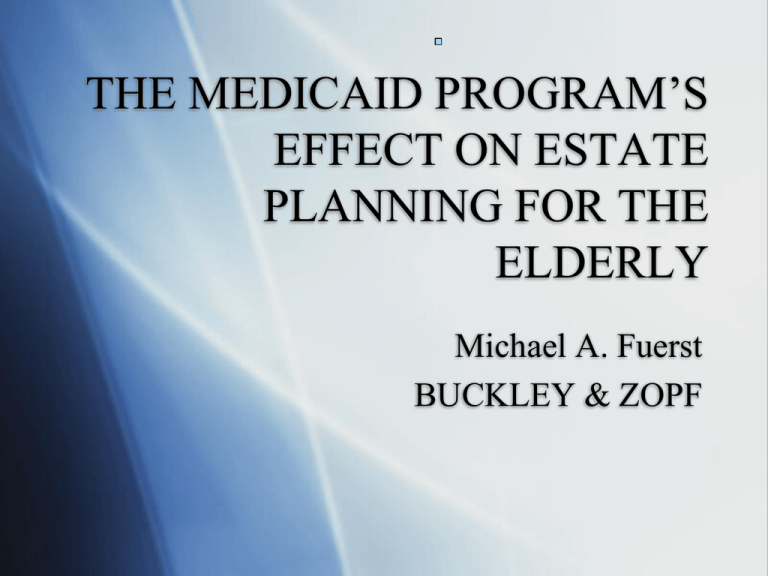
THE MEDICAID PROGRAM’S EFFECT ON ESTATE PLANNING FOR THE ELDERLY Michael A. Fuerst BUCKLEY & ZOPF OBJECTIVES OF MEDICAID ESTATE PLANNING Protection of community spouse 1. adequate income, resources 2. prevent impoverishment Assure care for institutionalized spouse Maximize estate for heirs DIFFERS FROM STANDARD ESTATE PLANNING A. Standard estate planning techniques will not work B. Gifts are problematic C. Grantor trusts mostly ineffective D. Traditional ownership concepts do not necessarily apply MEDICAID PROGRAM Needs based health insurance program Income and resource limitations Only health insurance which pays for nursing home care Medicare Health insurance for Social Security retirees Does not cover long term care in a nursing home Covers skilled/rehabilatative care in nursing home ELIGIBILITY FOR MEDICAID $2500 assets. Income below State reimbursement rate for nursing home.(approximately $4300/mo) Spousal Impoverishment Rules 1.Income Rules 2.Resource Rules INCOME RULES Community (healthy) spouse may protect up to $1822/mo of ill spouse’s income. If high shelter (housing) expenses up to $2739. None of healthy spouse’s income attributable to ill spouse. Ownership- “name on the check” concept If no document, 1/2 of income attributable to each spouse. Income An immediate payment annuity is treated as income of the owner/annuitant. Social Security or a pension is treated as the income of the individual who is entitled to receive it Wages Interest/Dividends Loan Example Ill spouse- social security and pension$3000; Healthy spouse- $750 social security Healthy spouse entitled to keep at least $1072 of ill spouses income. If shelter expenses are high may keep additional $917(750+1072+917=$2739) Example Healthy spouse- social security and pension-$3000; Ill spouse- $750 social security Healthy spouse entitled to keep all $3000 Healthy spouse entitled to an unlimited amount of income if in his/her name RESOURCE RULES: All resources are countable regardless of which spouse holds title or jointly owned. The “marital pie” Countable Resources Stocks, bonds, savings and checking accounts; IRA and 401K accounts Annuity and insurance policies Real estate-other than the principal residence Resource Assessment. “Snapshot” of countable resources. As of date of first continuous period of institutionalization. Even if application for Medicaid is later. Spousal Share • Maximum countable resources protected level for community spouse - $109,560. • All other resources to benefit institutionalized spouse Spousal Share One half of total countable resources to a maximum of $109,560. If total assets $300,000 healthy spouse only entitled to protect $109,560, not $150,000. If total assets $100,000 healthy spouse only entitled to $50,000. Minimum protected amount is $21,912. If total assets $40,000 healthy spouse keeps $21,912. Although community spouse may use the remaining assets for his/her benefit as well. Spousal Share Assets less than $43,824- $21,912 Assets between $43,824 and $219,120 One-half Assets more than $219,120 -$109,560 The family home is an excluded resource As long as it is used as the residence of the community spouse Up to a maximum equity value of $500,000 for ill spouse. Other Excluded Resources: motor vehicle furniture and personal possessions prepaid funeral irrevocable burial trust Deeming of Resources Stops as of Date of Eligibility for Medicaid timing is crucial no restrictions on what community spouse does with these resources sale of home-no claim by Medicaid TRANSFER OF ASSET RULES Transfers between spouses are not disqualifying. Gifts/transfers for less than adequate consideration are potentially disqualifying Transfers After February 7, 2006 “Look Back” Period: 5 years from first date individual is both institutionalized and applies for Medicaid applies to all gifts, including trusts. . Period of Disqualification: Equal to the total uncompensated value of all gifted assets Divided by state average nursing home cost ($8,421.11) Commencing on the date of application for Medicaid for nursing home care. All gifts disqualify regardless of size. Example Gift of $84,211 to pay for college for grandchild made on Jan 1, 2010 Apply for Medicaid Jan 1, 2014 Disqualification period-10 months ($84,211 divided by $8,421/mo) Disqualification period commences on date of application for Medicaid:1-1-20114 Exempt Transfers To spouse To sibling who has “equity interest” and has resided in home for 1 year To child who has resided in home for 2 years and provided care enabling recipient to stay out of nursing home To disabled or minor child Trusts 3 types of trust recognized: Revocable Irrevocable/grantor retained interest Irrevocable/no grantor retained interest Revocable Countable resource Residence will be countable Subject to lien recovery Irrevocable -Retained Interest Income only Right to principal-available asset regardless of trustee’s discretion Grantor’s residence considered countable asset Risk of inclusion if Grantor retains incidents of ownership ( right to borrow, power of appointment, Grantor as trustee) No clause or requirement in trust precludes it from being considered under Medicaid program. Irrevocable-No Retained Interest Transfer-must cover 5 year disqualification Not treated as income or asset. Congress and State have tried to make the use of trusts more difficult.Rules do not apply to trusts created on or before August 10, 1993. ESTATE RECOVERIES New Hampshire has an expanded definition of “Estate” for recovery purposes “Estate” “Estate” includes not only probate assets but also property held by the recipient as a joint tenant, tenant in common or holder of a life estate. RSA 167;14-A Property in a revocable trust is subject to recovery as well Possible recovery against irrevocable “income only” trust to the extent of the life interest in the income “Estate” Enforceable only against the estate of the recipient/institutionalized spouse-55 or older; not against estate of surviving spouse Not enforceable against estate if child under age of 21 or disabled Life Estate/Joint Tenancy Joint ownership and life estate which avoid probate, will not now avoid the lien. Life estate valued as of one minute before date of death based upon actuarial tables Joint tenancy valued as percentage of the total value (e.g. 50%). Lien on Home Not enforceable against home of surviving spouse ( or minor or disabled child of recipient) Not enforceable if: sibling has resided with recipient for 1 year and has equity interest; or, child has resided for 2 years and provided care to keep recipient out of nursing home Estate RecoveriesAnnuities Annuities require the State to be the primary beneficiary for Medicaid payments made to annuitant or spouse. If State not named then purchase of annuity will be deemed a transfer for less than adequate consideration Planning: Protection of Community Spouse Re-title assets in healthy spouse’s name. Apply for Resource Assessment as soon as possible. Do not need to be eligible for Medicaid to apply for resource assessment Planning: Protection of Community Spouse Convert countable resources to excluded resources. (payoff mortgage, make improvements to home,buy car). Insure greatest amount of income in healthy spouse’s name. After institutionalization spend down ill spouse’s share - for benefit of healthy spouse.(pre-pay taxes, purchase annuity). After Medicaid eligibility, convert excluded resources to liquid resources. ANNUITIES Countable asset unless immediate annuity Convert from countable asset to income Convert after Resource Assessment Not a transfer for less than adequate consideration Annuitization for “period certain”cannot exceed life expectancy pursuant to CMS standards The State must be primary beneficiary for any Medicaid provided to annuitant or spouse Maximizing Estate for Heirs Transfers before 60 months Long-term care insurance Irrevocable Trusts - are they of any use? Life estates Change will of healthy spouse All assets in name of healthy spouse Risks of Gifting Unable to pay for care for entire 5 years Gifts made to children no longer available Spent by kids Divorce or death of child Bankruptcy of or lawsuit against child Choice of Law The location of the Nursing Home controls which State’s Medicaid rules apply. Legal residence is irrelevant VIII. RULES OF THUMB A. Property transferred more than 60 months before institutionalization will be protected B. Property transferred within 60 months of institutionalization will cause disqualification. C. The rules will change 1. IS THERE A DIFFERENCE BETWEEN MEDICARE AND MEDICAID OR IS THE FEDERAL GOVERNMENT TRYING TO CONFUSE ME? 2. WHO IS ELIGIBLE FOR MEDICAID FOR NURSING HOME CARE? 3. IF A SPOUSE GOES INTO A NURSING HOME DOES THE NURSING HOME OR MEDICAID TAKE CONTROL OF OUR SAVINGS? 4. IF A SPOUSE HAS TO GO INTO A NURSING HOME DOES THE HEALTHY SPOUSE HAVE TO SPEND ALL OF HIS/HER ASSETS FOR THE CARE OF THE ILL SPOUSE? 5. IF MY ILL SPOUSE HAS TO GO INTO A NURSING HOME WILL HIS MUCH LARGER RETIREMENT INCOME HAVE TO GO WITH HIM? 6. DO WE HAVE TO SELL OUR HOME IF ONE OF US MUST GO INTO A NURSING HOME TO BE ELIGIBLE FOR MEDICAID? 7. DOES IT MATTER IN WHOSE NAME THE ASSETS ARE TITLED WHEN DETERMING WHAT MUST BE PAID TO THE NURSING HOME. 8. WHEN DOES THE MEDICAID PROGRAM DETERMINE WHAT AMOUNT OF ASSETS MUST BE USED FOR NURSING HOME CARE? 9. IS A LIEN PLACED ON THE HOME OF A HEALTHY SPOUSE BY THE MEDICAID PROGRAM? 10. IF MY CHILDREN OWN PROPERTY JOINTLY WITH ME WILL THEY BE REQUIRED TO PAY OFF THE LIEN? 11. CAN THE HEALTHY SPOUSE SELL THE HOME?. 12. IS THERE A 5 YEAR DISQUALIFICATION FROM MEDICAID FOR ANY GIFTS I MAKE? 13. CAN AN INDIVIDUAL GIVE AWAY HIS/HER ASSETS TO BECOME ELIGIBLE FOR MEDICAID? 14. IF A SPOUSE IS JUST ABOUT TO GO INTO A NURSING HOME IS IT TOO LATE TO PROTECT ASSETS? 15. IF IT LOOKS LIKE A SPOUSE MIGHT HAVE TO GO INTO A NURSING HOME, WHAT SHOULD WE DO? Michael A. Fuerst, Esq. Buckley & Zopf PO Box 1485, 233 Broad St Claremont, NH 03743 603 542 5114 603 543 1570 fax Mfuerst@buckleyzopf.com November 2011

